Your Skin Has Thr Power to Protect You Art Explaied
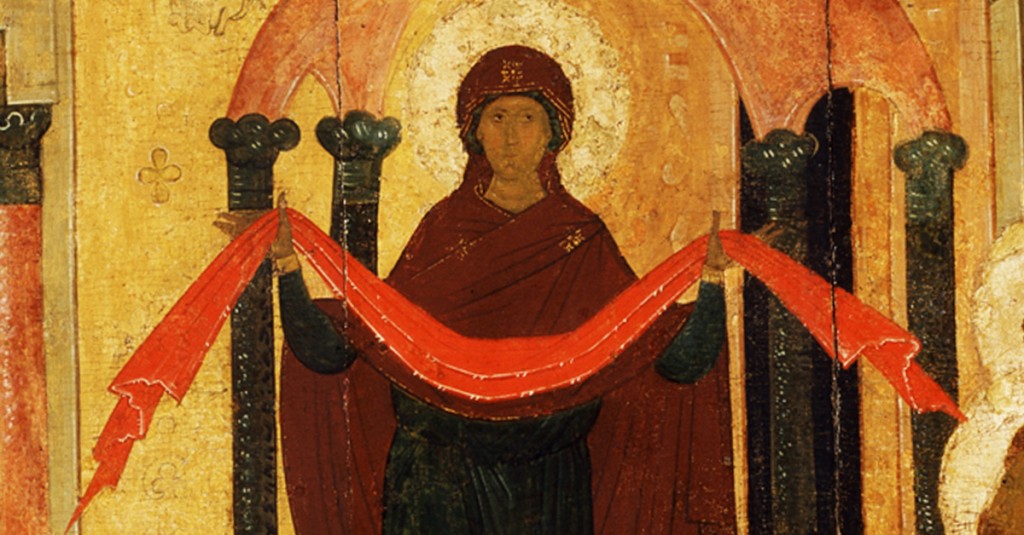
We live in a confused time. Many of the bones foundations which concur the world together have been made delicate. Up/down, center/periphery, inside/outside have all been eroded in their power to frame existence as we sentinel floodwaters rise around u.s.a.. One of the foundations systematically attacked through sophisticated rhetoric and political credo is the complementary relationship between masculine and feminine. Masculine and feminine are the two solid pillars on which take stood all societies everywhere at all times until the modern era, and the rapport betwixt them is akin to the primordial relationship between heaven and earth itself. However, as each activeness causes an equal and opposite reaction, the unrelenting modern efforts to create a "pure private" in part by eliminating the social differences between men and women has only been equaled in its ferocity by the simultaneous degrading and objectification of women. It is precisely because powerful elements of guild take actively pursued a gender-neutral ideology in which women should, nay, must inhabit whatever and all masculine attributes, that women take equally had to bargain with an unprecedented loss of personhood and a reduction in popular culture to want inducing machines.
But for those who can see the glimmering spark even in the darkest places, there is a hidden mystery in the otherwise truly unfortunate reduction of women to their sole capacity to seduce, 1 which hides a very powerful vision of the feminine for those who dare take hold of the snake past the tail. When seen correctly, seduction is actually an example of the most essential ontological categories. It is a version of the power of manifestation itself, if we run into power in the manner I have explained elsewhere within the traditional dyad of power and authority, potestas and auctoritas, potential and actuality.
I see some readers picking up stones already, but please comport with me. Seduction is an interesting aspect of human behavior, for it is non activeness on the globe in its ain right, but rather a type of operation which either voluntarily or involuntarily elicits desire to deed in others. Information technology is not a commandment, non an injunction which addresses the will of a person, nor is it an human action of violence meant to constrain or control. Rather, it is a mix of showing and hiding, the revealing of a mystery expected to call attention and focus action on the object or person which is wittingly or unwittingly seducing the onlooker. This I believe is the nearly profound attribute of seduction, one which we find too in modern advertising. Seduction is an "request for attention", the opening or framing of a space of action inside the menstruum of phenomena. When a swain encounters the world, he might harbor an "thought" of the relationship between the sexes: boy meets girl, marries daughter, has children, etc. But the world is composed of 51% women, the young man is surrounded by them. Certainly we are dealing with a multilayered process, but at least at the offset, a particular adult female must announced in his experience of the world and somehow "stand out" from the others, elicit in him the desire to pursue a relationship with her in particular rather than all the other women on his horizon. In that mode seduction and desire precede activity, in many ways precede selection even.
Of course seduction is only a facet of the larger thought I am hoping to ultimately arrive at. The highest case of the opening of a space for being and action can be seen in the feminine through the womb, the bringing forth of body and providing nurture for the kid (for what is nurturing if non providing possibility for a existence to unfold?). In paying attention to the poetic imagery surrounding the Mother of God, one will discover many examples of how she appears every bit the space, the support, the ground from which the Logos appears. If Christ is the dominicus, then she is the east. If Christ is the celebrity, then she is the ark. If Christ is the pearl, so she is the shell[ane]. Whatsoever quick glance at hymnography will render dozens of these comparisons.
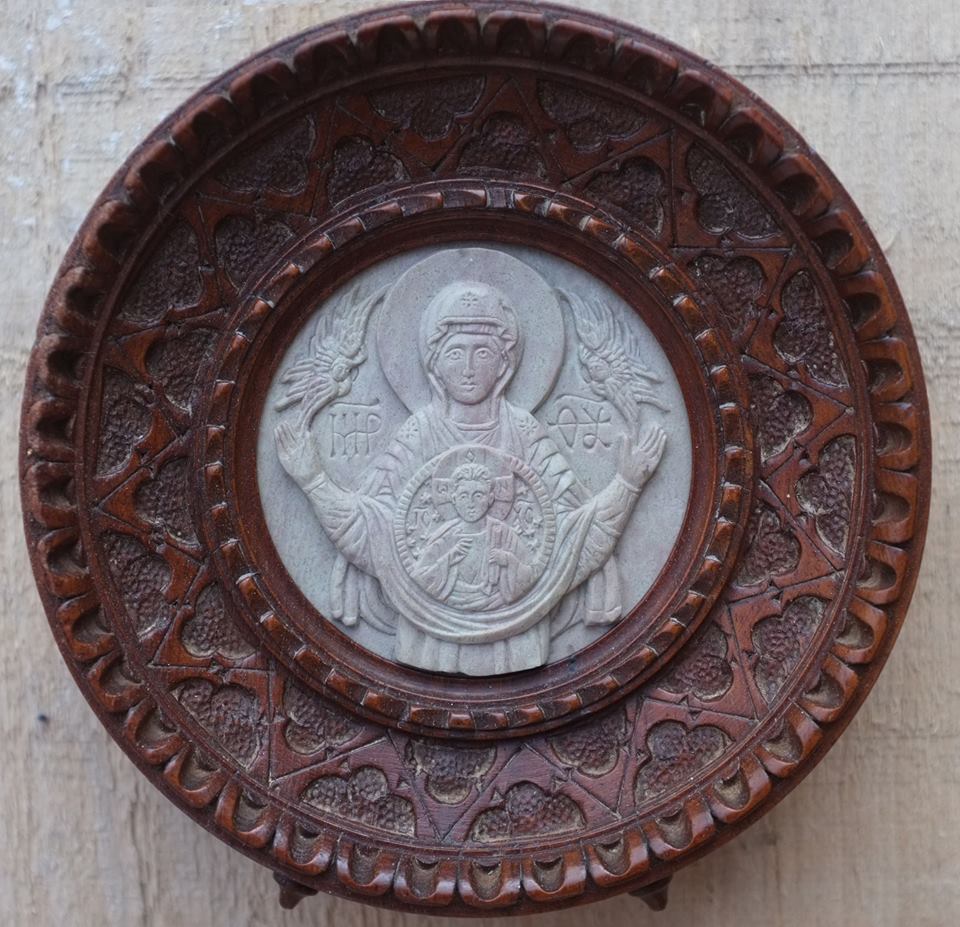
If we broaden the construction, nosotros will run across the type of the Mother distributed into social extensions of infinite and body which have traditionally been associated with the feminine. These include the household, the urban center and the church, both as an bodily building likewise as the more communal vision of the Church as the body of Christ. I contend that in the story of Christianity, women both as brides and as mothers will systematically precede and surround. As we see the Theotokos showing united states of america her son in the famous Hodogetria icon, women will be there to open up the way unto Christ and the cross. And merely as the Hodogetria was paraded on the walls to save Constantinople, only equally the Mother of God was seen by St. Andrew of Constantinople spreading her veil over the people in protection, other women saints in imitation of the Theotokos, will also exist at that place every time there is need to open up or protect sacred spaces, the cities, the churches and of course the icons.
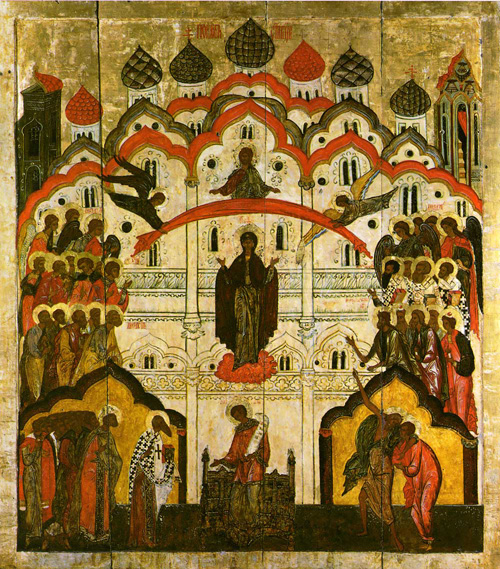
Recasting the Temptress every bit Hodogetria
There has been much ink spilled on Eve as the temptress, and in modern times we have wanted to downplay this aspect of the Genesis story equally much every bit possible. Though I understand why and sympathise with those who have done then, I fright in eliminating this aspect completely we will become blind to the wider implications of its structure. If nosotros ignore how Eve tempted Adam unto decease, opening to him the possibility of dying, of taking on the garments of skin and all that entails in terms of the multiplying of Man into Humankind, the development of the arts and the motility out of the garden into the world, so we will not understand how this aforementioned structure volition play itself out into the remainder of the cosmic story.
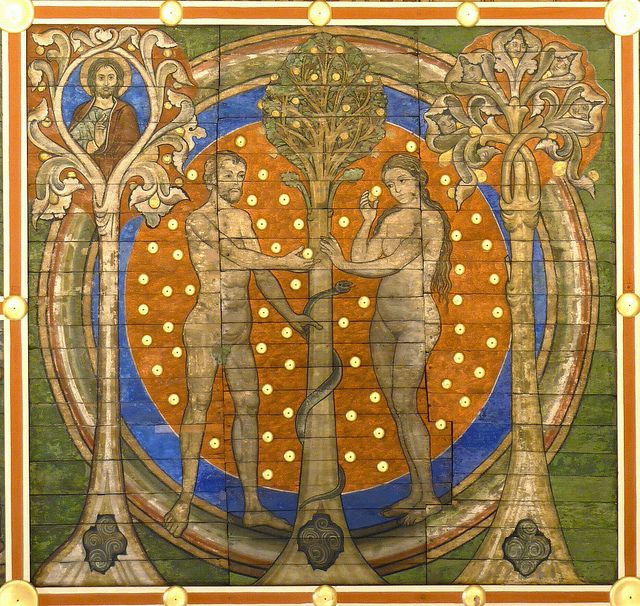
In the Bible there are many examples of seduction unto expiry[2], but to fully empathize them, nosotros must go on in mind the duality of death which I have explained elsewhere. Death is moving away from the unity of a center (middle, garden, holy land, etc.) or a descent back into the earth. This includes both a dissipation into "dust", but also a "vaccine effect", a blazon of external supplement where decease becomes a protection from decease, hence the patristic paradigm of the dead garments of skin given to Adam and Eve at the fall to protect them. This vaccine effect is also the root of ritual sacrifice which reaches its apex in Christ trampling downward death by death.
One of the surprising stories denoting this seduction into death while joining it to the office of the mother is the story of the Jael in the book of Judges. Jael is a Kenite woman who kills Sisera, an enemy king, as he flees a losing boxing. Jael invites Sisera into her own tent, connoting a sexual proposal[3], but then covers him with a blanket, gives him milk and puts him to sleep, which are the acts of a mother, only to then murder him by impaling him with a pale through the caput. The role of the seductress and the mother are brought together to show a powerful aspect of the feminine. Jael does not contrive Sisera, does non tell him what to practise, only rather invites him and answers his concrete needs before killing him.
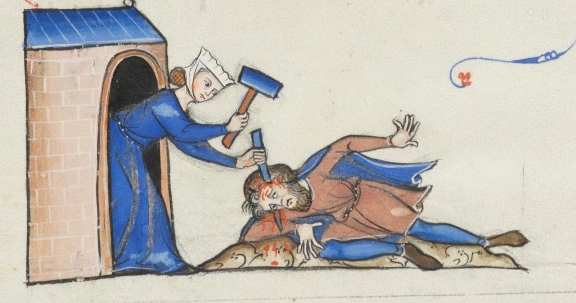
Every bit usual, in Christianity there is a transfigured recasting of OT attestation models, and a identify where nosotros see this surprising construction reappear is in the icon of the Nativity. In the icon of the Nativity, the cave plays the role of Jael's tent, and Christ is shown wrapped in a cloth as Sisera was wrapped in a blanket. The Female parent-Child human relationship is ready out conspicuously in the Nativity icon, Simply there is some other strain of meaning, since the cave, and more than specifically the manger in its pattern and its part as feeding container for animals, are meant to evoke the tomb (which I have discussed earlier). And so in the nascency of Christ from the Theotokos, Christ's torso appears already both equally the space for his life but also the infinite for his death. Of class the Theotokos does not kill Christ, still the means of death are analogical even so. In the story of Jael, the pale is an explicit image of the nailing of Christ to the cross, and though in the icon of the Nativity this does not need to appear literally, the cross is implied even in the cruciform halo around Christ'due south head.
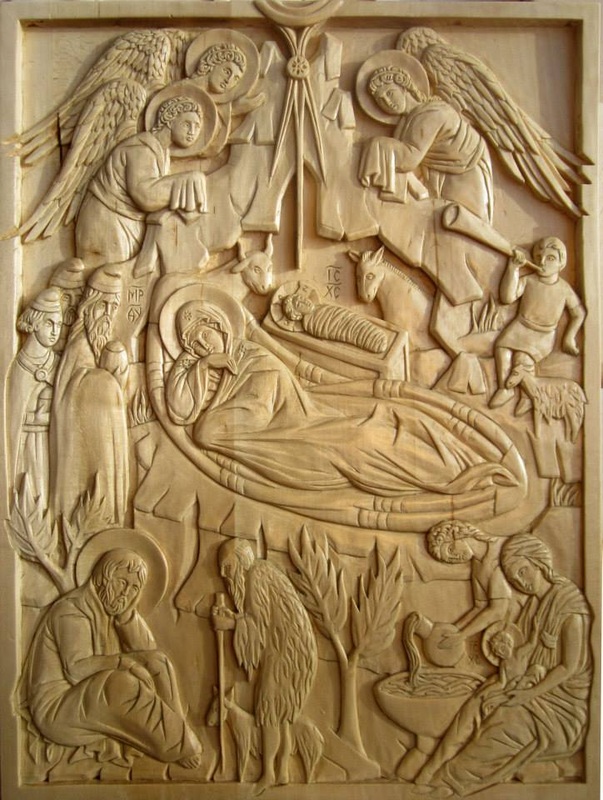
In the New Testament, another of the stories which can help us see the opening of a infinite for activeness and more specifically a tempting unto death is in the Wedding ceremony at Cana. This story is extremely rich and complex and elucidating it fully would crave an entire book, withal at that place are a few details which could help usa forth on our subject area.
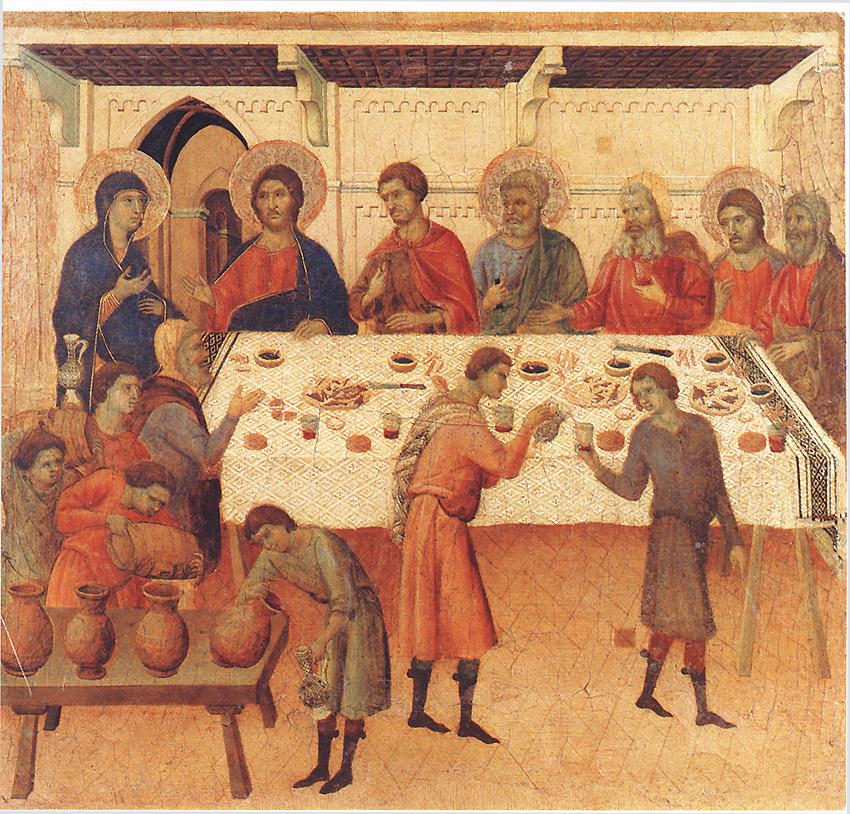
When the wine runs out at the wedding, the Theotokos comes to Christ and tells him: "The wine has run out." This annotate is the argument of a problem, which implicitly contains a call to action. It is a puzzle or a question for the Logos to answer and acts as the frame for his response. Hearing this, Christ would not change a stone into bread, that would not make sense. He must decide if, and if so how, he will provide a solution to the problem. In this manner, the Theotokos is providing a "body", framing the possibility into which he will begin the process of manifesting the Logos. Christ'south answer is telling. "Adult female, what does this have to do with me? My 60 minutes has not yet come." My hour has not still come up? As we will see later in the Gospel of St-John, this expression relates to the death of Christ[4]. And and then my own question echoes that of Christ; what could a lack of wine at a nuptials have to do with his death? Already though we come across that it is related, even if we might not understand why[five]. We see that the Theotokos is not merely opening a body, a path, for the manifestation of the Logos, simply this body is already seen as leading to expiry at the very get-go. Somehow she is mirroring the human action of Eve, who giving her husband the fruit, did not tell him what to do, did not constrain him in whatever mode, but by placing the possibility before him, Eve "framed" Adam's course of activity and seduced him unto death. Of class in Christianity this motif, this catholic puzzle volition be completed, leading from death unto salvation and resurrection. Every bit the New Eve, as the Hodogetria, the Female parent of God will also invite us to gustatory modality of the fruit of the knowledge of Heaven and World hanging on the bow of the cantankerous, seducing us too unto dying to ourselves then we can commune with her son.
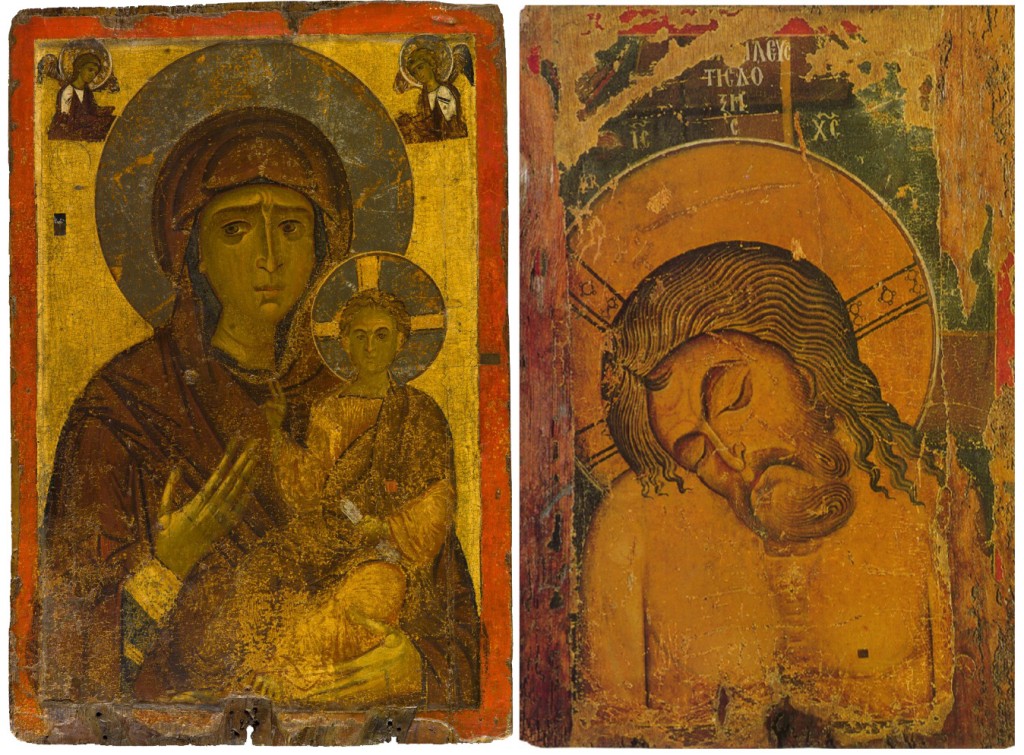
Opening the way
The story does not end here. Even the well-nigh superficial look at Church building history will show us women beingness the subconscious precedent of men at every turn, the ones whose whispers hide deep under public historical accounts. They are wives, mothers, grandmothers, sisters who by their example, their prayers and oft secret gestures, entice their sons, husbands, brothers, grandsons into the Church building. The story starts already in the Bible, with St-Mary Magdalene preceding the apostles in encountering the resurrected Christ.
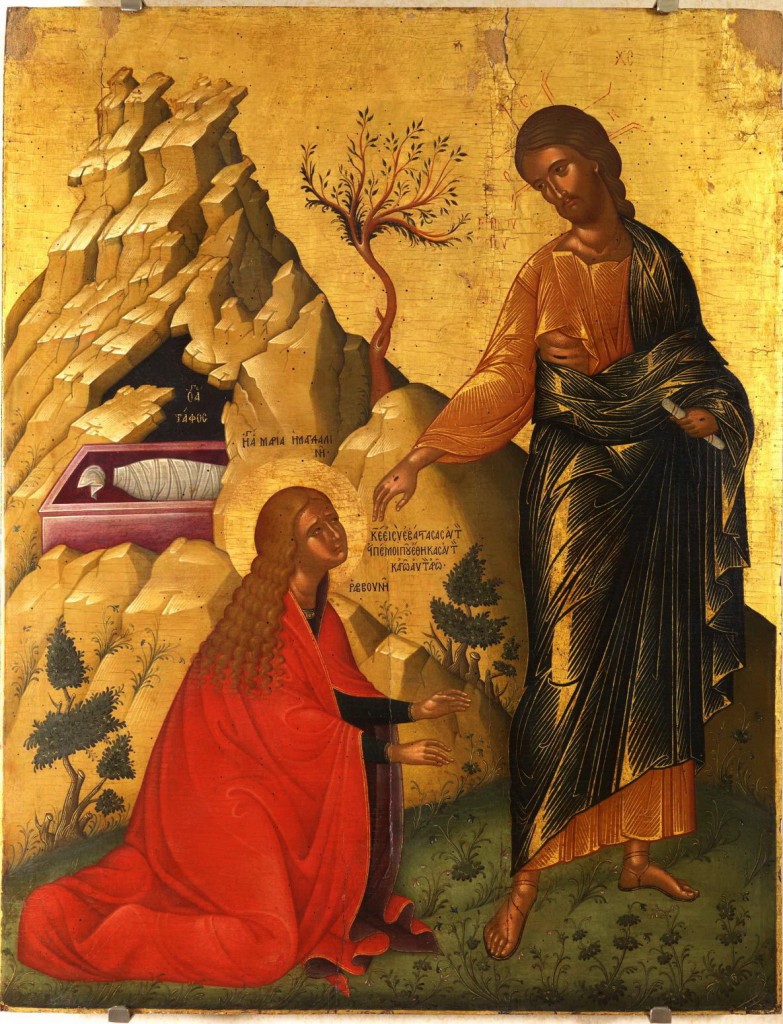
There is likewise the wife of Pontius Pilate, sending him a bulletin to have naught to do with Christ's condemnation. The wife of Pilate is an interesting example equally she will later exist venerated as a saint under the name St-Procula (or Procla). She likewise sets the phase for a blueprint of the "Christian royal woman" who precedes the conversion of the king. This story is then common and is found at then many of the major historical conversions that all I tin can give is a list for the reader to explore. Examples I could find include St-Helena, the mother of St-Constantine the Bang-up the beginning Christian Roman Emperor, St-Olga the grandmother of St-Vladimir of Kiev the first Christian Rex of the Rus, St-Clotilde the wife of Clovis the beginning Christian Carolingian King.
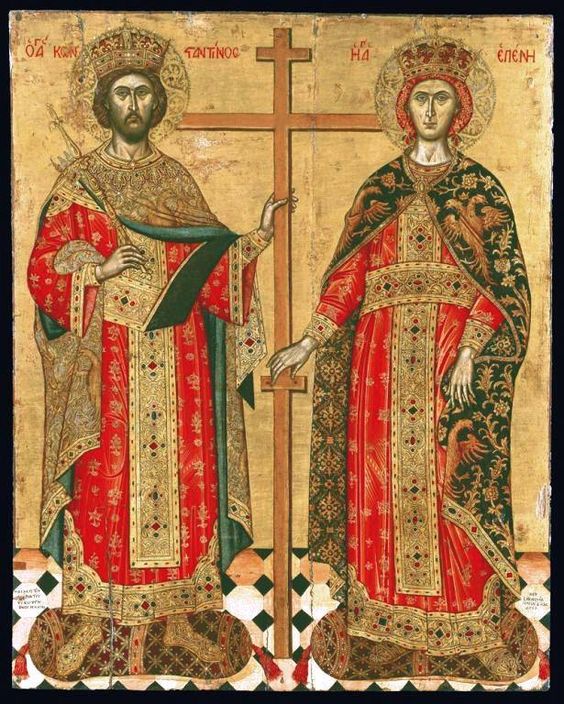
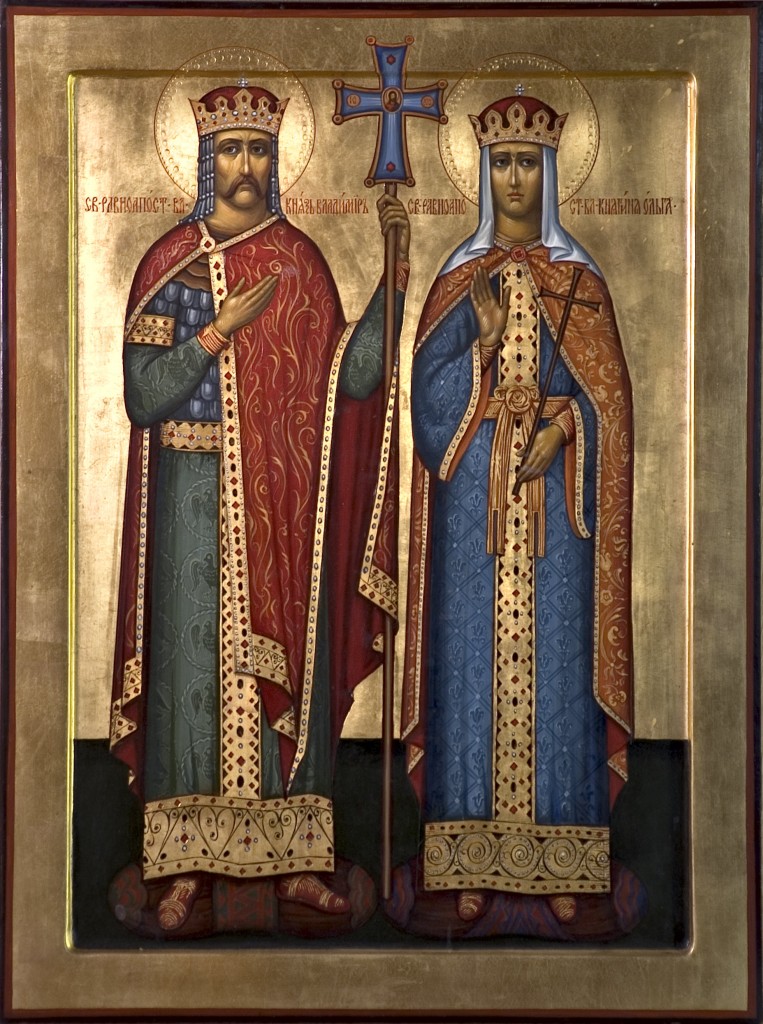
These are the near known, but more hibernate in the margins, such as Bertha the married woman of King Aethelbert of Kent or Doqus Qatun, the Christian married woman of Hulagu Kahn[6], the Mongol Khan who destroyed Bagdad in 1258, and others whose stories take not reached us.
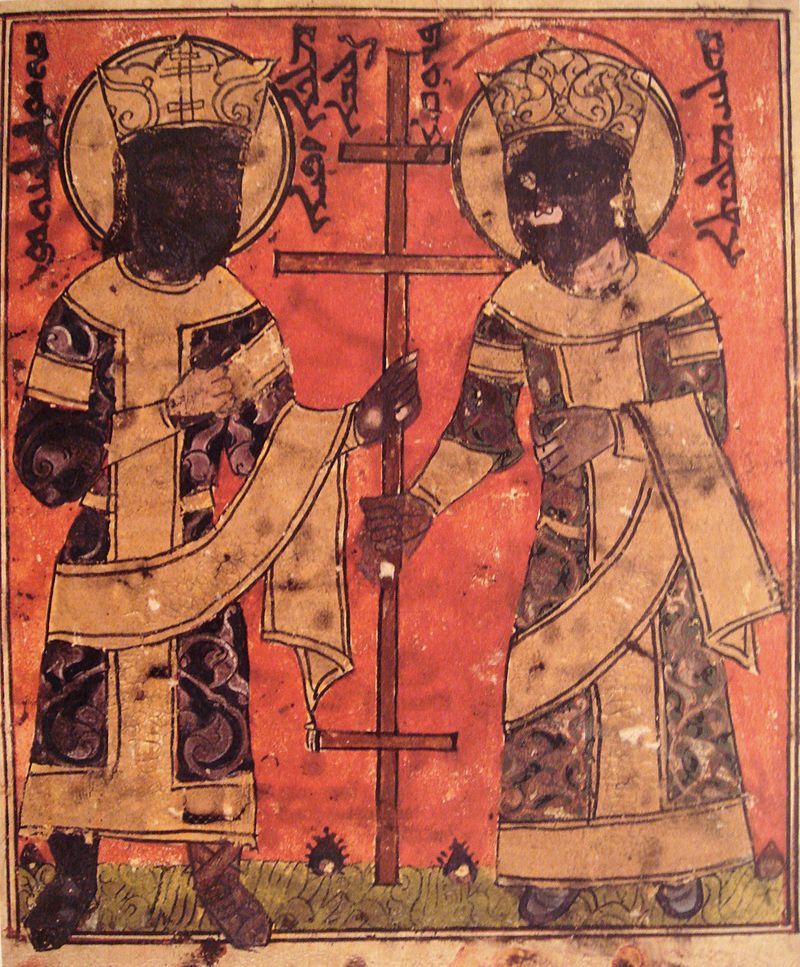
All these women were Christian first, opened the mode to Christ, and though the historical record does not always attribute conversions to their direct influence, the pattern is at that place for those who perceive the mystery. Other women will precede the great theologians, these examples include St-Macrina, sister of the Cappadocian fathers St-Basil the Great and St-Gregory of Nyssa in the East, and St-Monica the mother of Blest Augustine in the West.
Sacred Space
As I mentioned before, the notion of the trunk as taking its root in the feminine, in the womb, has social extensions. The extension of living space is the house, the metropolis and church building seen equally feminine in their representations. Looking at these extensions of the body volition provide the key to seeing many of the actions of majestic women as an important root and protection for liturgical fine art in Christianity. This begins with St-Helena equal to the Apostles, female parent of St-Constantine who initiates the rebuilding of Jerusalem, defining the shape of the urban center and its shrines, therefore spatially mapping the life of Christ through a series of churches in the Holy Land. Another powerful example is how during the Nika riots of 532AD, when a mob attacked the palace complex, destroying the original Hagia Sophia church, the Emperor Justinian wanted to abscond, but it was the Empress Theodora who convinced him to stay by saying, "The Royal Purple is the Noblest Shroud". What a powerful almost prophetic argument bringing together the notion of habiliment, the city, seduction and the duality of expiry. The rebuilding of Hagia Sophia would become the model for Orthodox Churches until today.
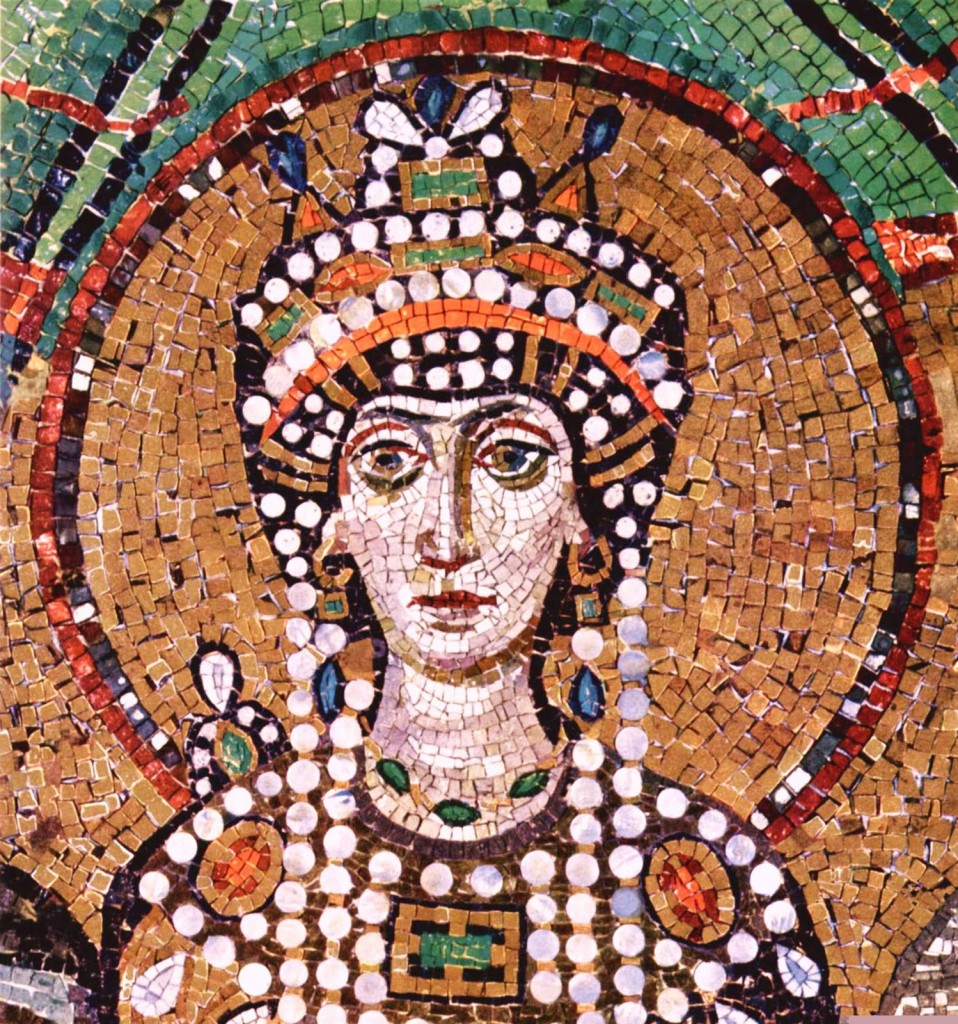
Only it is in the story of icons that nosotros find the highest examples of the role of women in the physicality of the Church and its fine art. Just as the Female parent of God stretches her veil as protection, during the unabridged fourth dimension of iconoclasm, information technology was women who preserved the practice of iconography in Constantinople. Information technology was Empress Irene who called the seventh ecumenical council which fabricated official the veneration of icons, and it was St-Theodora the married woman of Theophilos who finally restored icons in what has come up to be historic equally the Feast of Orthdoxy.
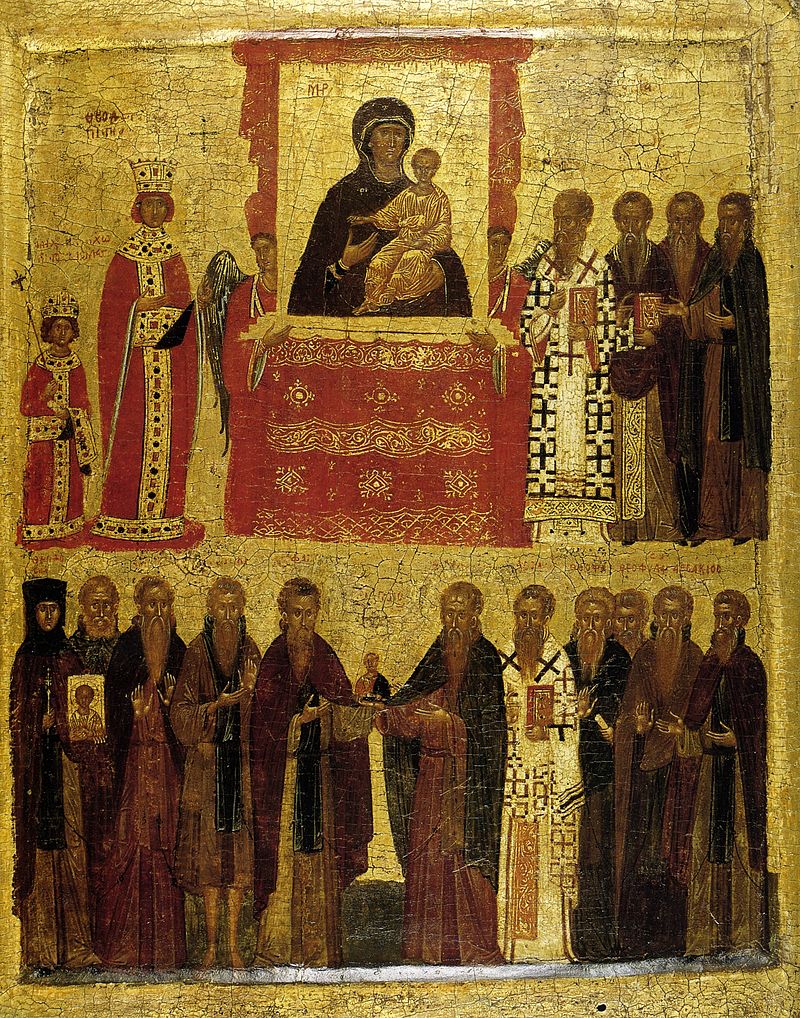
We know mostly of Irene and Theodora and their role in the restoration of icons, simply Mother Nectaria who publishes Route to Emmaus Journal has written a wonderful commodity in which she explains that it was not just those two, but that iconodule wives were chosen past iconodule Empresses for their sons, thereby creating a secret chain of women preserving the veneration of icons even when their husbands were hostile to images. Mother Nectaria fifty-fifty suggests, with disarming arguments, that the Byzantine practice of the "bride-show", where a helpmate for an Emperor was chosen through a kind of beauty pageant, might have been a strategy for the sitting Empress to chose an iconophile married woman for her son. If this is truthful, the unabridged story becomes a powerful tribute to beauty, seduction and the clandestine power of the feminine in the transformation of the world.
Female parent Nectaria tells a wonderful story of the time to come iconoclast Emperor Theophilos budgeted St-Cassiane who had been ane of the possible future brides called by his pace female parent at a bride-show:
"First drawn to Cassiane, the young Emperor approached her saying, "Through a woman came forth the baser things," implying the sin of Eve, to which Cassiane responded, "And through a woman came along the meliorate things," recalling the Incarnation."[7]
Displeased with this annotate, the futurity Emperor finally chose to marry another of the candidates, Theodora. St-Cassiane would later turn to monasticism and become a renown abbess and hymnographer. Finally, though the Emperor Theophilos was the about agog of iconoclasts, his married woman Theodora would restore the veneration of icons for good later on his death, proving indeed that "through woman came along the ameliorate things".
The restoration of the icons is in many means a "transformation of the garments of pare", for all these concrete images, these multiple versions of the invisible prototypes are subject to death, to disuse and destruction. Just the images are also the testimony of Christ and show how the garments of peel can get garments of glory, that death and multiplicity accept been inverse by Christ into vehicles of grace unto the ends of the earth. This is the mystery of Christianity itself, how the end of Eve'south seduction would render all at in one case, all that was promised fifty-fifty in ill-will. Homo would both die and get god, ane attribute holding the other by the manus through the ability of the cantankerous, which is both the tree of knowledge and the tree of life. The question posed by Eve in the Garden would finally be fully answered, the seemingly bottomless gap established in that primordial moment would be filled to overflow by Christ who is all in all.
——————————————————————————————-
[1] For more examples of these relations, see Henry Macguire, Body, Clothing, Metaphor: The Virgin in Early Byzantine Art in The Cult of the Female parent of God in Byzantium: Texts and Images, Ashgate Publishing. 2011.
[2] Different examples will play out the relation betwixt seduction, desire and expiry in multiple ways which would demand further elaboration. But a summary list worth thinking about would include the wives of Abraham and Isaac being kidnapped by Abimelech (Gen. 20,26. In this example, it is rather the threat of death and not decease itself), the rape of Dinah (Gen. 34) the hiding of Joshua and Caleb by the prostitute Rahab (Josh. 2 This story is like to the one of Jael, yet has an inverted ending, where the subconscious enemies are not killed but her ain metropolis falls), Esther and the death of Haman (Est. seven), Salomé and the death of St-John the Baptist (Mat. 14) , Judith and the decease of Holofernes (Judith 10-13). There are too important not- Biblical versions of this, the near obvious is the story of the Trojan war.
[3] For a description of why this is then and how the Hebrew denotes sexual hospitality, see Thalia Gur-Klein, Sexual Hospitality in the Hebrew Bible: Patronymic, Metronymic, Legitimate and Illegitimate Relations, Routledge, 2014. p.39
[4]Compare to John 12:23, 13:1, 17:1
[v] But what does changing water into wine have to do with the autumn or with the death of man? To answer we need to consider the other case in the Bible where there is a clear transition between water and wine, and this is found at the Biblical origin of wine. After Noah leaves the ark once overflowing waters are abated, he plants a vine. Noah then gets drunk on the wine he produces, strips and passes out. The story plays out like an inversion of the Garden of Eden story, for the unconscious naked Moses becomes a stumbling stone for Ham who stares at his nakedness and is cursed for his indecent gesture. This re-establishes the curse and fall which had been briefly held in bank check past the new rainbow covenant fabricated with God. And and then Noah'due south wine coming after the flood becomes the place of the new fall. Wine is as well an interesting version of the garments of skin, human technology, since it is made past turning the procedure of decomposition against itself. The very procedure of the "dying" of the fruit, when contained, creates an intoxicating potable. In social club to sympathize all of this further, one can also ponder the places in the Bible where water is turned into blood, for example the beginning plague of Arab republic of egypt which somewhen led to the death of the first born and to the Passover-Pascha, also Christ'due south last moments in the Garden where he sweats blood.
[vi] Hulagu did not convert, simply still portrayed himself as the new Constantine in his iconography.
[7] Mother Nectaria Mclees. Byzantine Bride-Shows and The Restoration of Icons, in Road to Emmaus #51, Fall 2012, p.57
mortensenprect1936.blogspot.com
Source: https://orthodoxartsjournal.org/sacred-art-and-the-power-of-women/
0 Response to "Your Skin Has Thr Power to Protect You Art Explaied"
Post a Comment